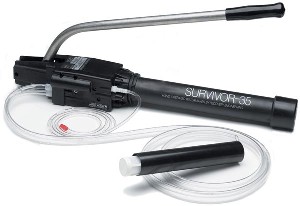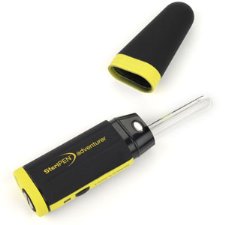Purification is something that can be easily accomplished, using a multitude of technologies that are available, ranging from boiling water, ceramic filters and ultraviolet light.
Most surface water contain some types of microorganisms (protozoa, bacteria, viruses) and/or pollutants (chemicals, foul odors, sewage, spilt fuel). Microorganisms are living microscopic cells that, when consumed, can cause diseases such as dysentery, cholera, typhoid and hepatitis.
Protozoa the largest of all microorganisms include such parasites as Giaridia Lamblia and cryptosporidium. Bacteria medium-size microorganisms include E. coli, Vibrio Cholerae, campylobacter, and salmonella, all of which are found in human and animal waste. Viruses are the smallest of all the microorganisms. They include hepatitis A and E, Norwalk virus, rotavirus, poliovirus and echovirus.
Treatment
Filtering
If the water is cloudy, the first thing to do is take out as much of the dirt as possible. If you have time, start by letting it settle. Put the water in a tall container and leave it for 12 to 24 hours. Carefully dip or pour the cleaner water at the top into another container. Clean the water as you put it in the new container by running it through a filter. The easiest filter is a coffee filter. If you don't have a coffee filter, use a paper towel, cheesecloth, a cotton plug in a funnel or a piece of clean t-shirt material or similar cloth. Change the filter whenever it gets visibly dirty.
Once water is filtered, it is fine for using to clean things like clothing and floors. Don't use water that you wouldn't drink to wash you face, rinse your dishes or clean kitchen utensils.
Once you have filtered the water, it has to be treated before it's safe to drink. The purpose of this is to kill all the germs that may be in the water. There are several ways to treat surface water for disease-causing microorganisms. Each method has its advantages and disadvantages. Realize that no method is perfect and sometimes combining methods is the best solution.
- Heat (boiling and distilling)
- Disinfectant (purification, chemical)
- Filters
- Light (ultraviolet).
Heat
Boiling
Boiling water has been the main way to disinfect water from microorganisms because it kills them all if done correctly. Water should be brought to a rolling boil for at least five minutes and preferably up to 10 minutes. If you live at high altitudes, add a minute for every 1000 feet above sea level. Bacteria and protozoa are dead at the first bubbles.
There are drawbacks to boiling water:
Boiled water tends to taste flat because there is no air in it. You can add the air back by pouring the water back and forth between two clean containers. This will also improve the taste of stored or bottled water.
- It does not eliminate many chemical pollutants, radiation or heavy metals.
- Boiling can require a lot of fuel and cooking equipment
- The long cool-down period
- Some of the water will evaporate before it is ready to drink
- The water will still have particulate substances in it (requires filtering)
- It does not eliminate poor taste or foul odors
- Difficult to treat very much water at a time
Solar Still
Solar stills operate upon the "greenhouse effect." A clear plastic barrier (a plastic bag, ground cloth, or a plastic grocery sack) is placed over a "source," such as the ground, tree branches or other organic materials. The sun's (solar) energy passes through the barrier and heats the source material. Moisture from the source vaporizes, rises and then condenses on the underside of the plastic barrier. The moisture is then collected as drinkable water. Solar stills are capable of distilling almost any tainted water, even seawater. Solar stills can condense drinkable water from substantially anything that contains moisture.
The only source materials that it cannot distill drinkable water from are materials that give off toxins, such as fluids with high amounts of chemicals, radiator fluids, and fuels.
Filtration
Glass fiber elements and compressed surgical paper (mildly expensive, medium durability, and usually not cleanable) also have small pores (0.2-1.0 microns). Like the ceramic filter, they remove only particulates and microorganisms, but they do not help much with pollutants. These are good low-cost filtering elements for home, backpacking and scouting needs, but they are not good for long-term storage because they can develop mold and mildew and they are hard to clean.
Hard-block carbon elements (less expensive, brittle, and not cleanable) have a small, but still effective pore size (0.4-2.0 microns). They are also used as an absorption filter. The best contribution that carbon makes to filtering is its ability to reduce chemical quantities, poor taste, odors and many pollutants. Because carbon is only mildly effective in filtering out particulates and microorganisms, it is mostly used as a second or third stage filter in home and portable water use. It is seldom used as a stand-alone filtering unit.
Chemical
Two primary chemicals are used for purifying water: iodine and chlorine. These two chemicals are lightweight, low-cost and relatively easy to use.
Iodine has been found to be very effective against viruses, bacteria, and protozoa with the exception of cryptosporidium. Using iodine has some drawbacks.
- Iodine is a short-term water-purification solution and should not be used regularly for more than three months.
- The colder the water you wish to disinfect, the more required time is needed for disinfecting.
- Because iodine is absorbed into dirt and debris, which is found in water, its purification dosage varies.
- Pregnant women and people with thyroid conditions should not drink water purified with iodine.
- Unpleasant taste of the water.
Chlorine bleach can also be used to purify water. The Federal Emergency Management Agency (FEMA) and the Red Cross have recommended using Chlorine Bleach to purify raw water. There are some drawbacks to the chlorination method.
- Chlorine is very poisonous and adding too much can cause illness, internal organ damage or even death.
- If the household bleach is over six months old, it may not have enough potency to disinfect.
- You should only add it at the time you intend to use your water, NOT when you store it.
Because of the limited shelf life of chlorine bleach, Granular Calcium Hypo chlorite is an alternative you might want to consider.
Ultraviolet
Comparison Chart of Treatment Methods
| Method/Device |
Neutralizes Pathogens |
Removes Particulars |
Removes Chemicals |
Affects Taste | Portable | Notes |
|---|---|---|---|---|---|---|
| Boiling | All | No | No | Leaves flat taste. | Yes |
Best method for killing pathogens. |
|
Filter (1 micron) |
Protozoa-All
Bacteria-Limited Viruses-Limited |
Yes | Some | Improves | Yes |
Effectiveness is based on pore size and membrane technology. |
| Purifier | All | Yes | Some | Improves | Yes |
Reduces all forms of pathogens. |
| Chemicals |
Protozoa-Limited
Bacteria-All Viruses-Limited |
No | No | Adds chemical tatste. | Yes |
Slow to neutralize protozoa. |
| Distillation | All | Yes | Yes |
Improves, can make taste flat. |
No | Very Slow |
| Ultraviolet Light | All | No | No | No | Yes |
Does not work as well in cloudy water. |


